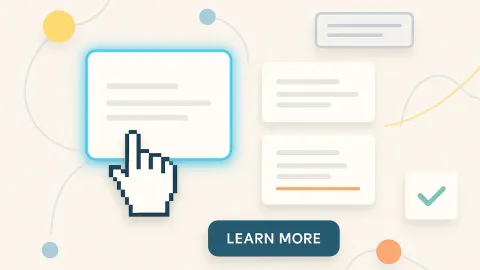CSS Vertical Centering: Complete Guide to 6 Essential Methods

CSS vertical centering has always been a classic frontend challenge. Unlike horizontal centering with simple text-align: center, vertical centering requires understanding different layout methods and their appropriate use cases.
This comprehensive guide covers 6 essential vertical centering methods with interactive examples, helping you choose the right approach for any scenario.
Why Is Vertical Centering Challenging?
CSS vertical centering seems difficult because:
- Box model design: CSS naturally flows from top to bottom
- Height calculation: Element heights depend on content, making calculations complex
- No vertical reference: Unlike horizontal centering with clear left/right boundaries
- Browser inconsistencies: Different methods work better in different contexts
Understanding these fundamentals helps us choose the right solution for each scenario.
1. Flexbox - Modern First Choice
Flexbox is the recommended solution for most vertical centering needs. It provides clean syntax, excellent browser support, and handles edge cases gracefully.
.flex-center {
display: flex;
align-items: center; /* Vertical centering */
justify-content: center; /* Horizontal centering */
min-height: 200px;
}Flexbox Vertical Centering
Flexbox Advantages:
- Clean syntax: Just three CSS properties
- Responsive: Works with any content size
- Flexible: Easy to adjust alignment
- Modern: Excellent browser support
Essential Flexbox Properties:
.container {
display: flex;
align-items: center; /* vertical: start, center, end, stretch */
justify-content: center; /* horizontal: start, center, end, space-between */
flex-direction: row; /* row, column, row-reverse, column-reverse */
}2. Position + Transform - Precise Control
This classic method uses absolute positioning combined with CSS transforms. Perfect for situations requiring precise control or when the element needs to be removed from document flow.
.position-center {
position: absolute;
top: 50%;
left: 50%;
transform: translate(-50%, -50%);
}Position + Transform Centering
Position + Transform Use Cases:
- Overlays and modals: Elements that need to float above content
- Tooltips: Positioned relative to specific elements
- Fixed positioning: Elements that stay centered during scroll
- Precise placement: When exact positioning is required
Key Points:
- Requires
position: relativeon parent container - Removes element from document flow
- Works regardless of content size
- Transform percentages are relative to element’s own dimensions
3. CSS Grid - Powerful 2D Layout
CSS Grid offers the most concise syntax for centering with place-items: center. Ideal for complex layouts requiring both horizontal and vertical alignment control.
.grid-center {
display: grid;
place-items: center; /* Shorthand for align-items + justify-items */
min-height: 200px;
}CSS Grid Centering
Grid Advantages:
- Concise syntax: Single
place-items: centerproperty - 2D control: Handles both axes simultaneously
- Future-proof: Modern standard for complex layouts
- Grid integration: Works seamlessly with grid layouts
Grid Properties:
.container {
display: grid;
place-items: center; /* Shorthand */
/* OR separately: */
align-items: center; /* Vertical alignment */
justify-items: center; /* Horizontal alignment */
}4. Table Cell - Legacy Compatible
The table cell method uses CSS table display properties. Excellent for scenarios requiring maximum browser compatibility or when working with legacy codebases.
.table-center {
display: table-cell;
vertical-align: middle;
text-align: center;
width: 100%;
height: 200px;
}Table Cell Centering
Table Cell Benefits:
- Universal support: Works in all browsers including IE8+
- Dynamic content: Adapts to content height automatically
- No transforms: Doesn’t require CSS transforms
- Reliable: Time-tested approach
Considerations:
- Changes element display behavior
- May affect CSS styling options
- Less flexible than modern methods
- Semantic concerns with table display
5. Line Height - Simple Text Centering
Perfect for single-line text centering. Set line-height equal to container height for instant vertical centering.
.line-height-center {
line-height: 200px; /* Equal to container height */
text-align: center;
height: 200px;
}Line Height Centering
Line Height Use Cases:
- Single-line text: Buttons, labels, simple headings
- Quick solutions: Fast implementation for text-only content
- Legacy support: Works in all browsers
- Minimal CSS: No additional properties needed
Limitations:
- Single line only: Breaks with multi-line content
- Fixed height: Container height must be known
- Text-specific: Doesn’t work with block elements
- Line-height conflicts: May interfere with text styling
6. Pseudo Elements - Creative Helper Method
Uses ::before pseudo-element as a vertical alignment helper. Particularly useful for images and inline content where other methods may not apply.
.pseudo-center {
text-align: center;
}
.pseudo-center::before {
content: '';
display: inline-block;
height: 100%;
vertical-align: middle;
}
.pseudo-center > * {
vertical-align: middle;
display: inline-block;
}Pseudo Element Centering
Pseudo Element Applications:
- Images: Centering images within containers
- Inline content: Mixed inline and block elements
- No extra HTML: Uses only CSS pseudo-elements
- Creative layouts: Unique positioning scenarios
Technical Details:
- Creates invisible helper element with
height: 100% - Uses
vertical-align: middlefor alignment - Requires
display: inline-blockon centered content - More complex but doesn’t alter document structure
Method Comparison & Selection Guide
Quick Decision Tree:
🎯 Choose Flexbox when:
- Building modern web applications
- Need responsive, flexible layouts
- Want clean, readable CSS
- Centering any type of content
🎯 Choose Grid when:
- Working with complex 2D layouts
- Need precise grid alignment
- Want the most concise syntax
- Building grid-based designs
🎯 Choose Position + Transform when:
- Creating overlays, modals, tooltips
- Need elements outside document flow
- Require precise positioning control
- Working with absolute positioning
🎯 Choose Table Cell when:
- Supporting legacy browsers (IE8+)
- Working with existing table layouts
- Need maximum compatibility
- Content height is unknown
🎯 Choose Line Height when:
- Centering single-line text only
- Want simplest possible solution
- Working with buttons or labels
- Height is fixed and known
🎯 Choose Pseudo Elements when:
- Centering images or mixed content
- Cannot modify HTML structure
- Need creative positioning solutions
- Working with inline content
Browser Support Summary:
| Method | IE Support | Modern Browsers | Mobile |
|---|---|---|---|
| Flexbox | IE10+ | ✅ Excellent | ✅ Excellent |
| Grid | IE10+* | ✅ Excellent | ✅ Excellent |
| Position + Transform | IE9+ | ✅ Excellent | ✅ Excellent |
| Table Cell | IE8+ | ✅ Excellent | ✅ Excellent |
| Line Height | All | ✅ Excellent | ✅ Excellent |
| Pseudo Elements | IE8+ | ✅ Excellent | ✅ Excellent |
*Grid in IE10-11 uses old syntax with -ms- prefix
Essential Code Snippets
Here are ready-to-use code templates for each method:
Flexbox Template:
.flex-center {
display: flex;
align-items: center;
justify-content: center;
min-height: 100vh; /* or specific height */
}Grid Template:
.grid-center {
display: grid;
place-items: center;
min-height: 100vh;
}Position + Transform Template:
.container {
position: relative;
height: 100vh;
}
.centered {
position: absolute;
top: 50%;
left: 50%;
transform: translate(-50%, -50%);
}Table Cell Template:
.table-center {
display: table-cell;
vertical-align: middle;
text-align: center;
width: 100vw;
height: 100vh;
}Line Height Template:
.line-center {
height: 100px;
line-height: 100px;
text-align: center;
}
.content {
vertical-align: middle;
line-height: normal;
}Pseudo Element Template:
.pseudo-center {
text-align: center;
height: 100vh;
}
.pseudo-center::before {
content: '';
display: inline-block;
height: 100%;
vertical-align: middle;
}
.pseudo-center .content {
display: inline-block;
vertical-align: middle;
}Best Practices & Tips
Performance Considerations:
- Prefer Flexbox and Grid for modern browsers
- Avoid excessive transforms on mobile devices
- Use
will-changesparingly for animated centering - Test on actual devices for mobile performance
Common Mistakes to Avoid:
/* ❌ Forgetting container height */
.container {
display: flex;
align-items: center;
/* Missing height! */
}
/* ✅ Always set container height */
.container {
display: flex;
align-items: center;
min-height: 200px; /* or 100vh */
}Responsive Design Tips:
/* Responsive vertical centering */
.responsive-center {
display: flex;
align-items: center;
justify-content: center;
min-height: 50vh; /* Smaller on mobile */
}
@media (min-width: 768px) {
.responsive-center {
min-height: 100vh; /* Full height on desktop */
}
}Accessibility Considerations:
- Ensure sufficient color contrast
- Test with screen readers
- Provide keyboard navigation
- Consider reduced motion preferences
@media (prefers-reduced-motion: reduce) {
.animated-center {
transition: none;
}
}Mastering these 6 vertical centering methods gives you the flexibility to handle any layout challenge. Start with Flexbox for modern projects, fall back to Position + Transform for precise control, and use specialized methods like Line Height for specific use cases.
Remember: The best method is the one that fits your specific requirements - consider browser support, content type, layout complexity, and performance when making your choice.



